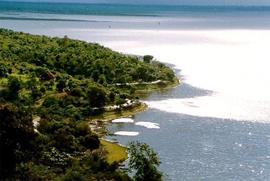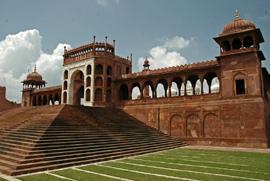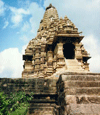|
|
 |
| Local Guide |
| |
| Places to visit in Bhopal |
| Bhopal–City of lakes |
History of Bhopal is one of the oldest in India and this city has a glorious past. The history of Bhopal Kaikhusrau Jahan Begum narrates tales of interesting, heroic and amazing incidents. Bhopal takes pride in its excellent blend of Islamic and Hindu cultures. Various dynasties have ruled the city over the years, contributing to its architectural and historical richness.
 The history of Bhopal starts with its foundation by the Parmara King Bhoj (1000-1055), who had his capital at Dhar. The city was initially known as Bhojpal named after Bhoj and the dam (`pal`) that he is said to have constructed to form the lakes bounding Bhopal. The fortunes of Bhopal rose and fell with that of its reigning dynasty. As the Parmaras declined in power, the city was destroyed several times and finally faded away into obscurity. The history of Bhopal starts with its foundation by the Parmara King Bhoj (1000-1055), who had his capital at Dhar. The city was initially known as Bhojpal named after Bhoj and the dam (`pal`) that he is said to have constructed to form the lakes bounding Bhopal. The fortunes of Bhopal rose and fell with that of its reigning dynasty. As the Parmaras declined in power, the city was destroyed several times and finally faded away into obscurity.
An Afghan soldier of the Orakzai tribe called Dost Mohammad Khan laid out the present city of Bhopal at the same site following the death of the Mughal Emperor Aurangzeb in 1707. He brought with himself the Islamic influence on the culture and architecture of Bhopal, the ruins of which is still evident at Islam Nagar. Bhopal was the second largest Muslim state in pre-independence India and was ruled by four Begums from 1819 to 1926. History of Bhopal has also experienced the rule of Begums, like the famous Qudisa Begum, who was the first female ruler of Bhopal and was succeeded by her only daughter Sikandar, who in turn was succeeded by her only daughter, Shahjehan. Kaikhusrau Jahan Begum was the last female ruler, and was succeeded by her son. The succession of the `Begums` gave the city such innovations as waterworks, railways and a postal system. History of Bhopal has witnessed several monuments as reminders of this glorious period.
It was one of the last princely states to sign the `Instrument of Accession` 1947. Though India gained Independence in August 1947, the ruler of Bhopal surrendered to the Indian government on 1 May 1949. Sindhi refugees from Pakistan lived in Bairagarh (Sant Hirdaram nagar), a western suburb of Bhopal. According to the States Reorganization Act of 1956, Bhopal state was incorporated into the state of Madhya Pradesh, and Bhopal was declared as its capital. The population of Bhopal rose rapidly since then.
 Even after India`s independence from British rulers, HH Nawab Hamidullah Khan, who had been titled `Aala Hazrat`, ruled Madhya Pradesh. He had his personal influence not only over the heads of the remaining states, but also over the eminent national leaders of the independent India. "Nai Raah", a weekly Hindi journal was started with the motive to raise the voice of people of Bhopal State, to move for merger. "Nai Raah" very soon became the mouthpiece of people of Bhopal State, promulgated the smouldering fire in the hearts of oppressed and suffering public of the state. Ultimately Sardar Patel had to speak up on behalf of the union government to pressurise for the merger. As a result, the agreement of the merger of the Bhopal State in the union of the independent India was signed on 30 April 1949. Even after India`s independence from British rulers, HH Nawab Hamidullah Khan, who had been titled `Aala Hazrat`, ruled Madhya Pradesh. He had his personal influence not only over the heads of the remaining states, but also over the eminent national leaders of the independent India. "Nai Raah", a weekly Hindi journal was started with the motive to raise the voice of people of Bhopal State, to move for merger. "Nai Raah" very soon became the mouthpiece of people of Bhopal State, promulgated the smouldering fire in the hearts of oppressed and suffering public of the state. Ultimately Sardar Patel had to speak up on behalf of the union government to pressurise for the merger. As a result, the agreement of the merger of the Bhopal State in the union of the independent India was signed on 30 April 1949. |
| |
| Best Season, Climate and Clothing |
Summers are too sweltering and very scorching to make a visit to this place and last from April to June. The winters are quite pleasant and last from November to February. July to September is the monsoon period and it receives the south-western monsoon rains. It is better not to make a tour of Bhopal during the summers and cotton clothing is simply ideal all the year round in Bhopal.
Touristplacesinindia.com is your authentic travel guide on Bhopal and provides useful information on the hotels and tourist attractions of Bhopal. |
| |
 |
| |
| Van Vihar |
| A wild life sanctuary with White Tigers as a specialty |
 |
| |
| Manav Sangharalay |
| Famous for the display of Stone Age articles |
 |
| |
| Boat Club |
| You can speed and paddle the Boat |
 |
| |
| Birla Temple |
| The Temple famous for its built with White Marble |
 |
| |
| Bharat Bhawan |
| The place for caltural programs |
 |
| Mahavir Tekri |
| Famous temple of Lord Mahavir situated at Hill Top Entire Bhopal could be seen from this place & you can even enjoy the Ropeway |
 |
| |
| Places to visit from Bhopal |
| |
Bhojpur |
28 km from Bhopal, Bhojpur is famous for its exquisite 11th century shiva temple and lake built by Raja Bhoj has many Shiva images engraved on its walls, it also houses an enoumous shivalingam carved out of single stone. |
 |
| |
Bhim Betka |
46 km from Bhopal, The village of Bhimbetka is surrounded by the northern fringe of the Vindya Mountains, The range is covered by huge rocks. Recent discoveries of over 600 rocks shelters have revealed painting that date back to early Stone Age. |
 |
| |
| Pachmarhi |
195 km from Bhopal, Panchmarhi is Madhya Pradesh’s most verdant jewel. Each dawn of this lovely hill resort girdled by the Satpura ranges ushers in a day of tranquil beauty. The green shades that embraces the mountain flow quietly in to ravines, and every where one can hear the gentle murmur of flowing waters. |
 |
| |
| Places to visit in MP |
| Khajuraho |
450 Kms from Bhopal. This obscure village, a long way from anywhere, is on the world's culture map for its' 22 world-famous stone temples which were built by the Chandela kings between 950 AD and 1050 AD (originally there were 85 temples, but only these have survived). The most important are the Chaunset Yogini Temple dedicated to Goddess Kali, The Mahadev Temple, Chitragupta or Bharatji Temple with a lovely image of 11 headed Vishnu, Vishvanath and Nandi Temples, Lakshmana Temple, Visha Temple of Shiva (the largest and most typical of the temples). The Eastern group of temples consist of the Parasvanath Temple (the only Jain Temple surviving at Khajuraho), the Javeri Temple (dedicated to Vishnu), and other temples dedicated to Brahma, Yamuna and Adinath. Each temple, built of stone, is distinguished by carved spires and walls, where the subjects range from aesthetic depictions of major and minor deities and celestial beings to a variety of erotic sculptures. |
 |
| |
| Mandu |
350 Kms from Bhopal. The city of joy is famed for stories of the love of King Baz Bahadur, for his consort, Rani Rupmati. Originally the capital of the Hindu Parmar Kings in the 13th century it was later captured by the Sultans of Malwa. The ancient monuments include Hoshang Shah's Tomb, India's first marble edifice and one of the supreme examples of Afghan architecture, which served as a model for the masterbuilders of the Taj Mahal, centuries later. Also worth a visit is the Jami Masjid, inspired by the mosque of Damascus. |
 |
| |
| Sanchi |
68 kms from Bhopal, Sanchi has the distinction of having the finest specimens of almost all Buddhist architectural forms: Stupa, Chaitya, Temples and Monasteries, dating from 3rd century BC. The Great Stupa, the oldest stone structure in India, has magnificently carved gateways or toranas. The Ashoka Pillar that lies near the southern gateway is one of the finest examples of Ashokan pillars. The 5th century AD Gupta Temple is one of the earliest known examples of temple architecture in India. |
 |
| |
| Shivpuri |
311 kms from Bhopal in the state of Madhya Pradesh, was once the summer capital of the Scindia clan of Gwalior. Prior to that, its thick forests were the hunting grounds of Emperor Akbar. Today Shivpuri houses a wildlife sanctuary, the Madhav National Park, spread over an area of 156 square kms. The predominant species that inhabits the park is the deer, the commonest of them being the dainty chinkara, the Indian gazelle and the chital. Other common species are nilgai, sambar, blackbuck, sloth bear, leopard and the langur. |
 |
| |
Gwalior |
423 Kms from Bhopaland the northernmost city is famous for the magnificent hilltop Gwalior Fort, which contains a fine museum and an ancient temple. The sandstone fortress, which goes back more than 1000 years, dominates the city.
Man Mandir Palace, Gujari Mahal, Sas Bahu Ka Mandir, Teli Ka Mandir, Jai Vilas Palace & Museum, Tansen’s Tomb, Laxmi Narayan Temple, Birla Museum, Kilol Park are the chief places to visit in the city. |
 |
| |
Ujjain |
188 kms from Bhopal Ujjain is one of the holiest and oldest cities of India, was an important place during the reign of Ashoka. Famous for its Jyotirlinga shrine at Onkareshwar , it is one of the seven sacred cities of India. Once in 12 years, the mammoth "Kumbh Mela" festival is held here. The ancient shrine of Mahakala is one of its attractions. |
 |
| |
Orchha |
400 kms from Bhopal The capital of the Bundela Rajputs, between 1531 and 1783, Orchha seems to have frozen in time. The palaces and temples retain much of their pristine perfection. Some of the palaces are decorated with painted murals which represent the finest flowering of the Bundela school of painting. Orchha's fort complex has three impressive palaces placed in an open quadrangle: the Jehangir Mahal, built to mark Emperor Jehangir's visit to the city; the Raj Mahal, built by Madhukar Shah, the religious predecessor of Bir Singh Ju Deo; and the Rai Praveen Mahal, built for the famous musician-poetess paramour of King Indramani. The Ram Raja, Chaturbhuj, and Laxminarayan temples are worth a visit. Orchha also prides itself on its lovely garden, Phool Bagh. There are 14 cenotaphs or chhatries (memorials) to the rulers of Orchha, by the banks of the Betwa river. The Shahid Smarak commemorates the great freedom fighter, Chandrashekhar Azad who lived and worked in hiding in Orchha. |
 |
| |
Kanha National Park |
450 kms from Bhopal This forms the core of the Kanha Tiger Reserve created in 1974, under Project Tiger. Kanha boasts of about 22 species of mammals. Some of the inhabitants of this park are the gaur, the largest of the world's cattle; the sambar, the largest Indian deer; and the chausingha, the only four-horned antelope in the world. Some 200 species of birds inhabit the park. |
 |
| |
Bandhavgarh National Park |
450 kms from Bhopal Set amongst the Vindhyas, Bandhavgarh is a small national park, but it has the highest known density of tiger population in India. This is also known as White Tiger territory - these have been found in the old state of Rewa for many years. The other species found in abundance in Bandhavgarh are the gaur or Indian bison, the sambar, the barking deer and the nilgai. |
 |
|
|
 |
|